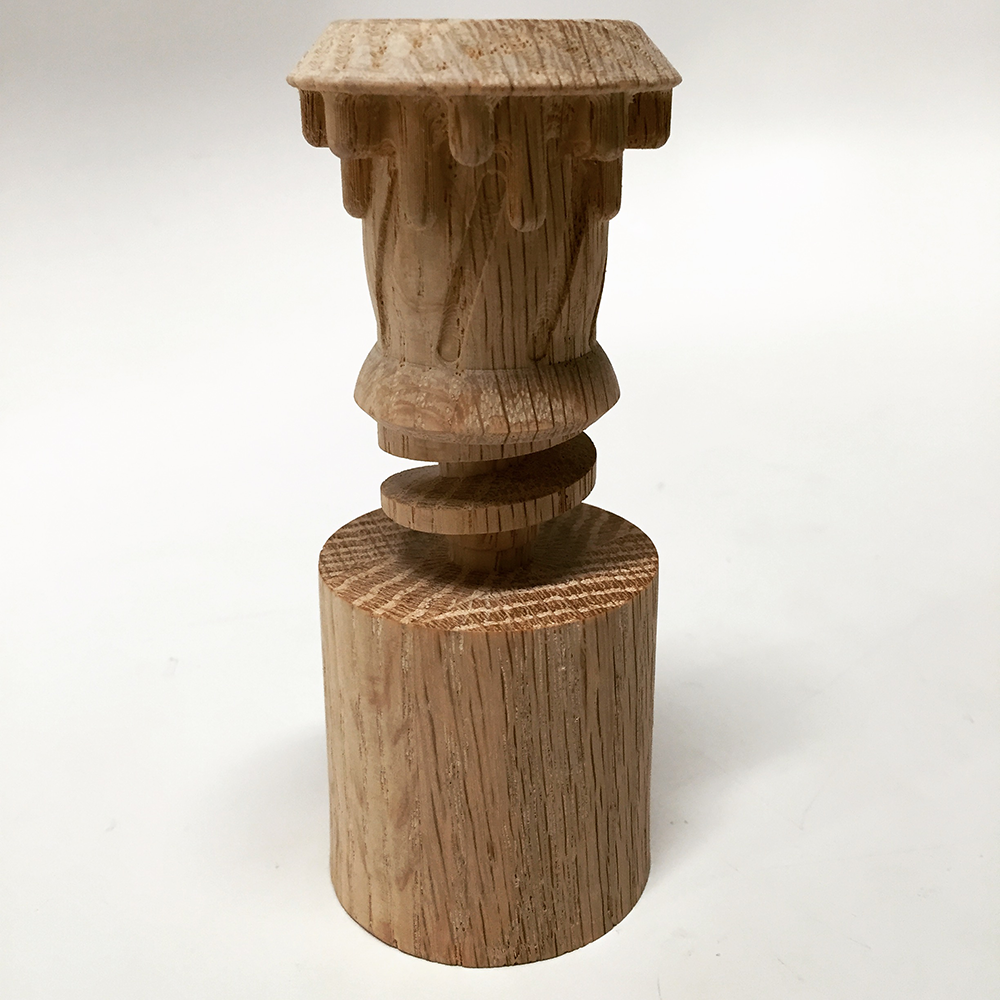More 4-Axis Milling

Another round with the Roland 4-axis mill, this time with a more complex, more original model. Unlike my first attempts, which were just excuses to get machining as soon as possible, the goal this time was to produce something resembling a finished piece. I didn’t really have a specific part in mind, so this model is a result of just experimenting with unfamiliar CAD functions, although it is very loosely based on the heatsink of an LED lightbulb.
I’m also working with some nicer material this time. Instead of blue foam and poplar, I’ve laminated together a stack of oak into a usable block. Technically I could mill this with the wood in a rectangular chunk, but it saves a lot of time to work with round stock, so before getting started I chucked it up on the wood lathe and turned it down to a cylinder. Using oak for this project is actually an iffy proposition, since despite creating a beautiful grain, oak’s fibers also can create significant tear out in turning and milling scenarios. I’m compensating with a very gentle finishing pass, so we’ll see how that turns out.
I’m still getting the hang of the CAM system for this mill. I’m using the MDX-540 with a rotary axis made by the Roland DGA Corporation, and it comes bundled with their SRP Player CAM processor. It’s got a wizard-like interface, and is generally designed for accessibility, but it’s also pretty restrictive, and I’m a bit frustrated using it. Hopefully there’s a compatible post-processor out there for Fusion 360.

Once it’s up and running, the Roland chips away at the material like a cartoon character eating corn on the cob.
This job wound up taking approximately 4 hours of cutting time. It’s kind of tedious to sit through, but at the same time it’s pretty hypnotic to watch. Here you can also see some of the challenges I ran into working on the CAM. If you go back to my original rendering, the columns on the left have undercuts behind them, but the Roland isn’t able to reach those spots so it just leaves the material in place. With only 4 axes there are limitations to this sort of cut, but I’d imagine there’s a way to do more than I managed to here.
At this point the roughing pass is complete. Obviously everything will benefit from some clean up, but it’s interesting to see which features are already nearly finished. In particular, I’m impressed at how well the threading on the right has come out. I don’t think I would have had nearly as much success cutting such a thin edge on a softer wood, so the oak is working well, but you can also see a huge amount of tear out around the fluted regions. That will all get refined, but the material is making itself felt to be sure.
At long last, the finishing pass is complete. There’s a lot of sawdust built up on the outside, but it looks pretty clean. Also, it doesn’t look like my fluting is all that visible. I designed all the features to be large enough to cut with an ⅛” mill, but it looks like I needed to compensate for them a bit more. Another thing to watch out for in CAD and another point of frustration with SRP Player.
Another challenge with the Roland is that it demands a huge amount of excess material. In the picture below, the cylindrical stock on either side of the model actually corresponds with the minimum dimensions required to cut this piece. It’s frustrating, since a lot of material goes to waste. Anyway, with the cutting complete (and after a little bit of sanding) I can finally remove the excess. I could just do this with a saw, but there’s some additional work I want to add, so I went back to where I started and chucked it up on the wood lathe.
The advantage of parting off the end using the lathe is that it leaves me in perfect position to bore out the middle of the bulb a little bit. There’s no functional reason to make the cut, but I like the look it creates. It’s also not something I could cut on the Roland. I’d need a fith axis for that. Sometimes the best CNC is your hand.
I actually decided to leave the bottom chunk of support as is, since it creates a nice built-in pedastal. A bit more sanding, a coat of tung oil, and voila, the finished product!
